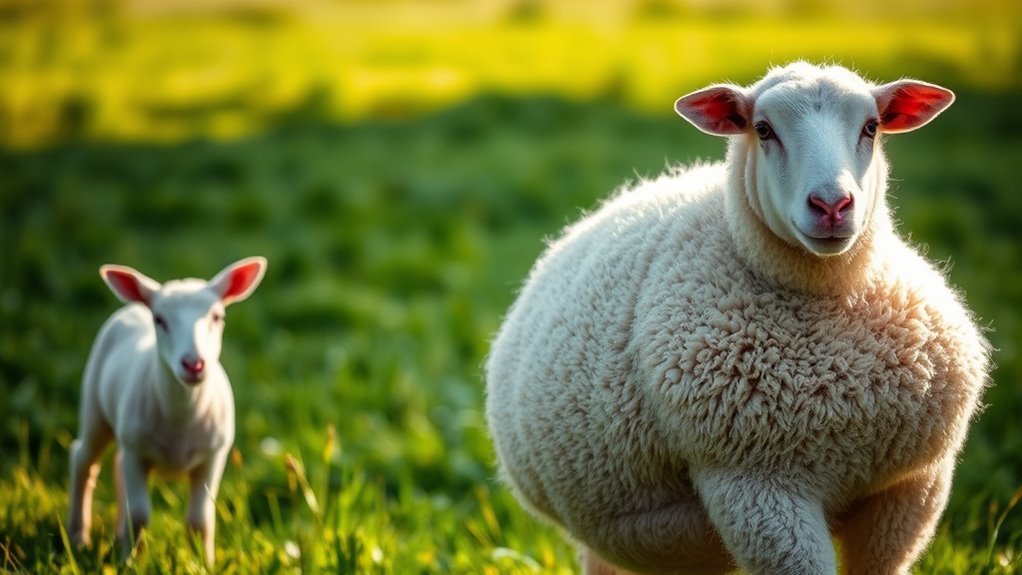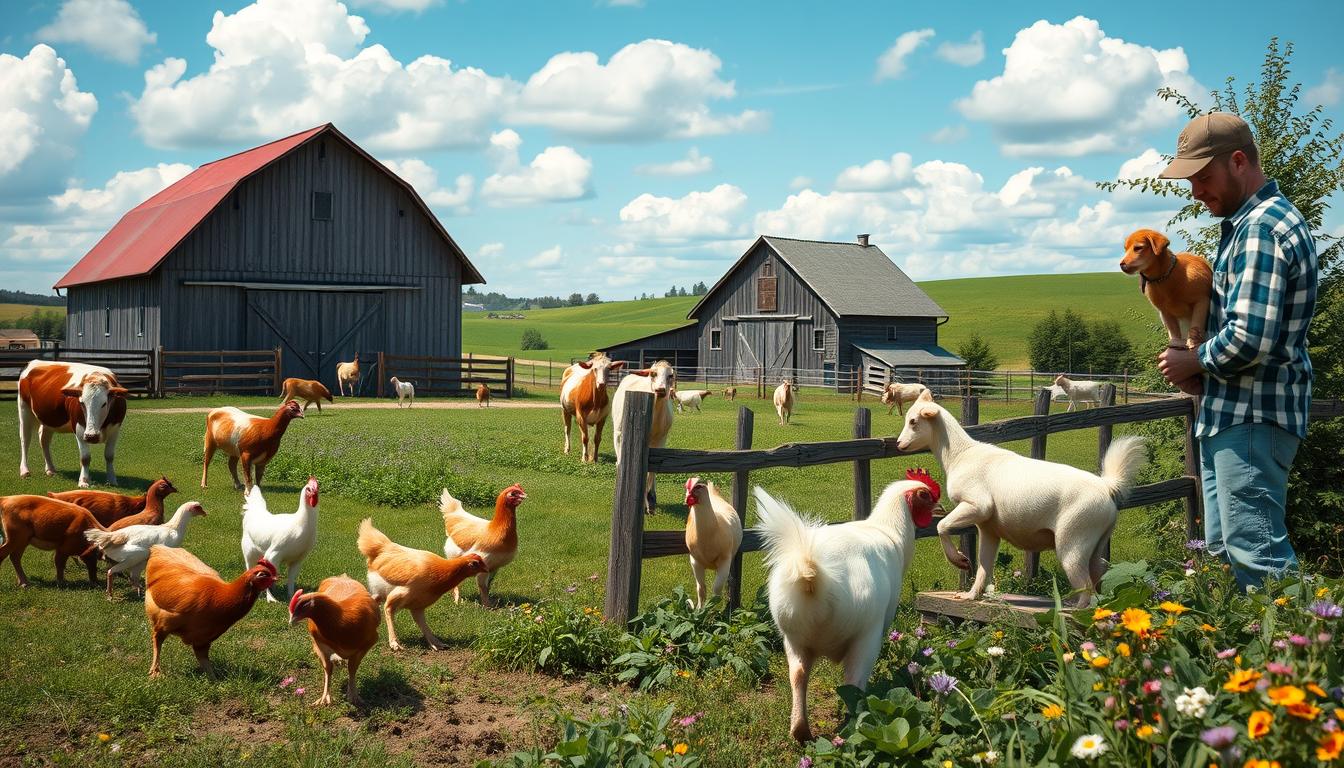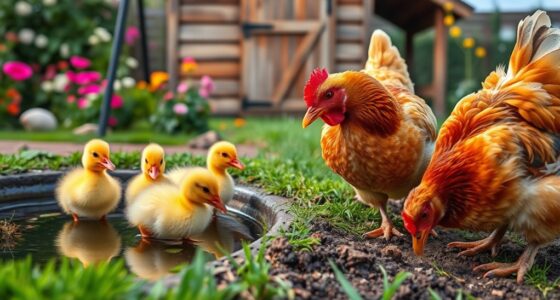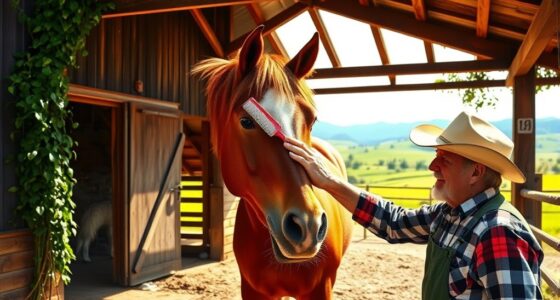As a ewe approaches lambing, look for physical signs like a larger, firmer udder and a swollen, dark vulva. You'll notice changes in her behavior, too; she may isolate from the flock and display restlessness. Pay attention to a sunken abdomen and the emergence of a mucous plug. These indicators signal that she's nearing labor. Understanding these signs can help you manage the situation effectively, and there's more to learn about ensuring a successful lambing experience.
Key Takeaways
- Udder development becomes larger and firmer about four weeks before lambing, indicating that the ewe is nearing labor.
- The vulva will swell and change color to a darker, more relaxed state as lambing approaches.
- Ewes often display restlessness, pacing, and may isolate themselves from the flock shortly before delivery.
- Nesting behaviors, such as pawing at the ground, signal that the ewe is preparing for lambing.
- A discharge of the mucous plug and the emergence of a water bag indicate active labor is imminent.
Nutritional Management Before Lambing
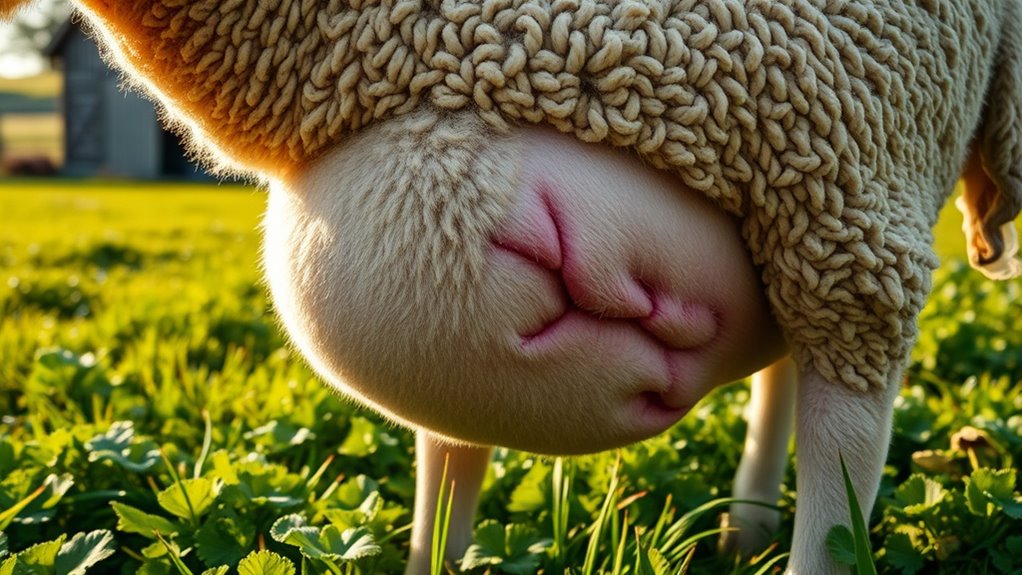
When preparing for lambing, you need to focus on the nutritional management of your ewes, especially during the last eight weeks of gestation. This is when 75% of fetal growth occurs, so you'll want to boost their energy and protein intake.
Aim for an 18-19% crude protein ration, increasing to 20-21% for ewes expecting multiple lambs. A 70kg ewe carrying triplets needs 16.7 megajoules of metabolizable energy daily.
For optimal health, aim for an 18-19% crude protein diet, increasing to 20-21% for ewes with multiple lambs.
Ensure high-quality forage is available and consider adding protein sources like soya bean meal for better milk quality. Don't forget about calcium—double their intake to prevent milk fever.
Regularly monitor their water availability and adjust feeding strategies based on litter size to maintain optimal health leading up to lambing.
Physical Signs Indicating Approaching Labor

As lambing approaches, you'll notice several physical signs that indicate your ewes are getting ready to give birth.
The udder will start to develop, becoming larger and firmer about four weeks before lambing, with colostrum filling it around ten days prior.
You'll also see the vulva swelling and changing color, becoming darker and more relaxed as labor nears.
The abdomen may appear full, with sunken sides as the lamb moves into position.
Look for a mucous plug discharge and the water bag emerging, signaling active labor.
Ewes may show restlessness, straining, or lift their tails, all clear indicators that lambing is imminent.
These signs help you prepare for the arrival of new lambs.
Behavioral Changes Noticed in Ewes
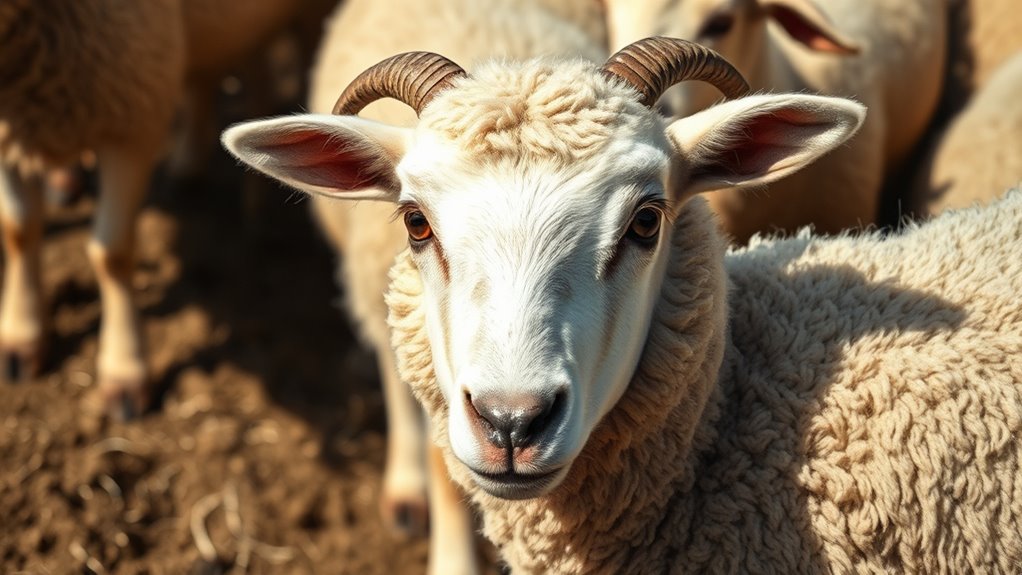
Ewes exhibit distinct behavioral changes as they approach lambing, making it crucial for you to observe their actions closely. You might notice a reduced interest in feeding, with some ewes skipping meals entirely, signaling an impending labor.
Socially, ewes often isolate themselves from the flock, and you could see increased aggression towards others. Restlessness and pacing are common too; they may look behind themselves or exhibit rapid breathing.
Watch for nesting behaviors, as ewes paw at the ground to prepare a comfortable area for delivery. Additionally, an increase in lying down and contractions indicates that lambing is near.
Understanding the Importance of Udder Development
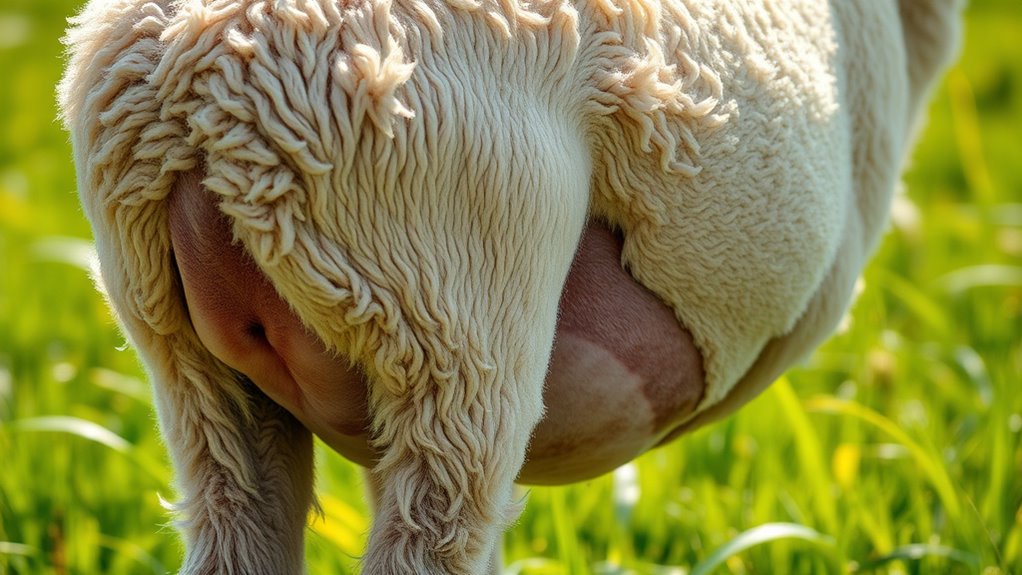
Udder development plays a critical role in ensuring the health and survival of newborn lambs. It begins about four weeks before lambing, with most growth occurring in the last four to six weeks of pregnancy.
Proper nutrition during this time is essential, as high-quality feeding supports optimal udder growth and colostrum production. You'll notice the udder becoming firmer and teats swelling within 24 hours of lambing, indicating readiness to provide vital colostrum.
This first milk is crucial for lamb immunity and overall health. Remember, poor udder development can't be corrected post-lambing, so focus on pre-lambing care.
Monitoring udder changes and ensuring a clean, nutritious environment will help you achieve the best outcomes for both ewes and their lambs.
Recognizing the Sunken Loin Area
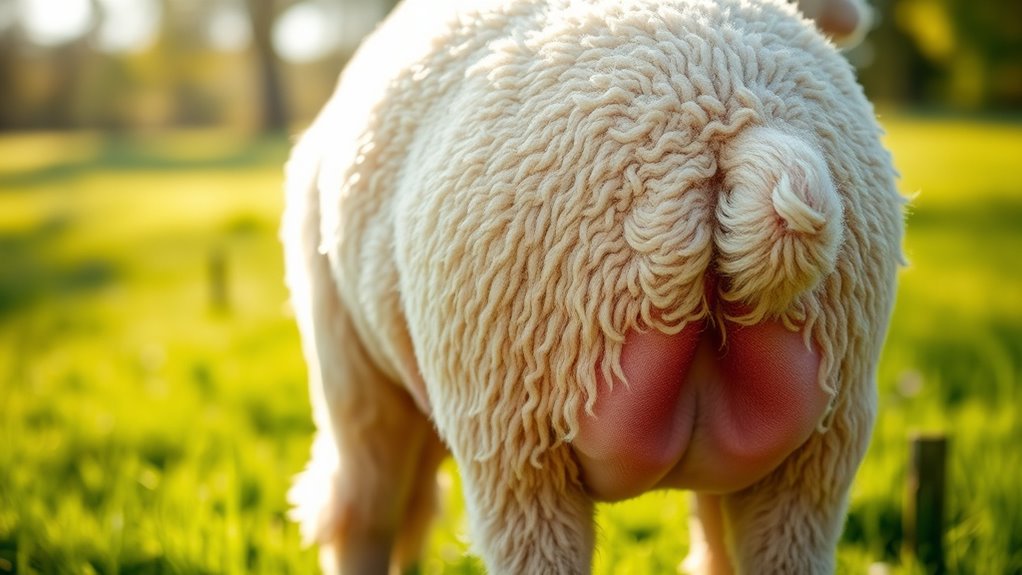
Monitoring udder development is just one part of preparing for lambing; recognizing the sunken loin area is another key indicator. This sunken area appears as cavities between the ewe's hipbones and last rib, indicating that lambs are shifting into position for delivery.
You'll notice this change occurring about 1-2 days before lambing, as the ewe's abdomen becomes more pronouncedly sunken. Regular observation is crucial during late pregnancy to catch these physical changes.
Additionally, look for other signs like a higher tail position, a swollen vulva, and an overall gaunt appearance. These indicators signal that lambing is imminent, helping you prepare for the upcoming event and ensure the ewe receives the care she needs.
Signs of Labor: Water Bag and Mucous Discharge
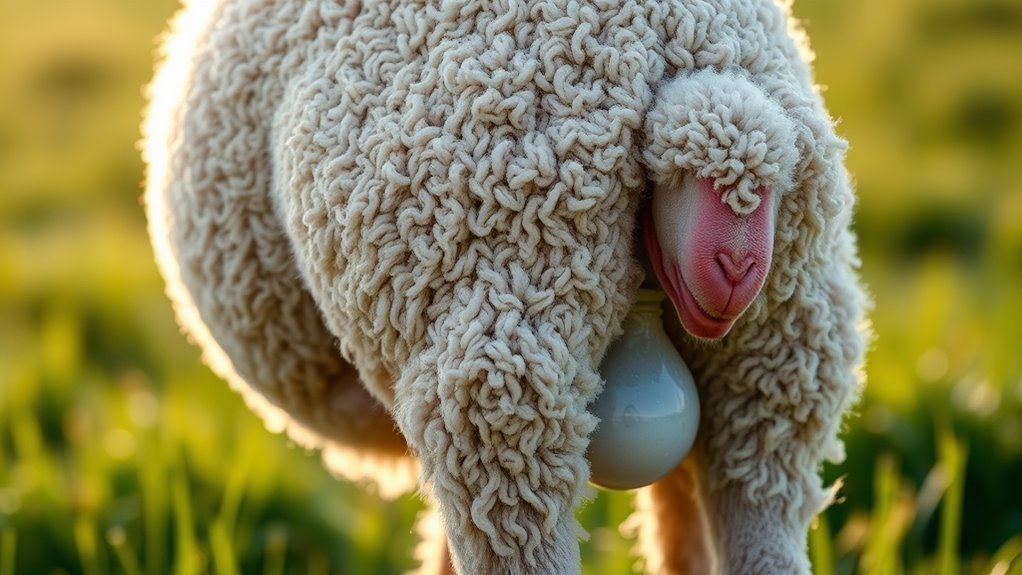
As labor approaches, you'll notice key signs that indicate a ewe is getting ready to lamb, with the appearance of the water bag and mucous discharge being among the most significant.
The water bag, a clear sign of labor, can appear as a small sac hanging from the vulva or burst, typically signaling that lambing will occur within an hour.
The water bag is a key indicator of impending lambing, often appearing as a small sac from the vulva.
In addition, increased mucous discharge often indicates labor progression. While a mucous plug may be discharged days before, visible mucous suggests that labor is imminent, especially when combined with behaviors like pawing or straining.
Regular monitoring after these signs appear is crucial to ensure that labor progresses smoothly.
Identifying Complications During Lambing

Recognizing signs of labor is just the beginning; complications can arise during the lambing process that require your immediate attention.
Watch for conditions like ringwomb, where the cervix fails to dilate, necessitating a caesarean section. Vaginal and uterine prolapses can occur, posing serious risks to both ewe and lamb.
Pay attention to abnormal presentations, such as breech or leg back positions, which can complicate delivery. Nutritional deficiencies, particularly selenium, can also lead to issues.
After lambing, be alert for signs of metritis or postpartum trauma due to excessive interference.
Techniques for Assisting During Difficult Lambing

When a ewe encounters difficulty during lambing, knowing how to assist can make all the difference in ensuring a safe delivery.
Start by preparing your lambing kit with essentials like disinfectant, lubricant, and gloves. If the lamb isn't positioned correctly, use lubrication and gently guide it into the proper alignment.
For breech deliveries, pull the hind legs first, then shift direction to ease the passage. If you find tangled twins, carefully separate their legs before proceeding.
Always monitor the ewe's energy levels; if she's exhausted, act quickly to pull the lambs. If complications arise, don't hesitate to contact a veterinarian.
Your prompt assistance can save lives and ensure a successful lambing experience.
Post-Lambing Care and Management Essentials

Effective post-lambing care is crucial for the health and well-being of both ewes and their newborn lambs. Start by ensuring the lambs are warm and nursing well; check for hypothermia or signs of starvation.
Keep an eye on the ewe's nutrition, maintaining a body condition score of 3 to 3.5, and provide fresh water and quality hay.
Process lambs within 24 hours, managing tasks like docking and identification. Ensure lambing pens are clean and well-ventilated, using heat lamps if needed.
Regularly monitor for mastitis and signs of illness in both the ewe and lambs. If complications arise, don't hesitate to contact a veterinarian to ensure the health of your flock.
Frequently Asked Questions
How Can I Tell the Due Date of My Ewe?
To tell the due date of your ewe, start by noting her breeding date, as sheep have a gestation period of about 145 days.
You can use lambing calculators for an estimate.
Look for physical changes like udder development and behavioral shifts, such as nesting, as the due date approaches.
Regular observation will help you catch these signs early and ensure you're prepared for the arrival of the lambs.
What Should I Do if a Ewe Refuses to Eat?
So, your sheep's on a hunger strike? Maybe it's protesting the quality of hay or just trying to catch your attention!
First, check for any health issues like lameness or dental problems. Offer some tasty treats, like grain, to entice her.
Ensure her environment's calm—no unexpected sheep yoga classes or thunderstorms! If she still won't eat, don't hesitate to call your vet. That's one drama you don't want to miss!
Are There Specific Breeds That Lamb Easier Than Others?
Yes, some sheep breeds are definitely easier to lamb than others.
EasyCare sheep require minimal assistance, making them a great choice.
Dorper sheep boast strong maternal instincts and high fertility, while Barbados Blackbelly often produces twins or triplets.
Katahdin and Blackhead Persian sheep are low-maintenance and adaptable to various climates.
Choosing these breeds can simplify your lambing experience and reduce the amount of care you need to provide during the process.
Can Stress Affect a Ewe's Lambing Process?
Imagine a calm, serene pasture where the miracle of life unfolds.
Unfortunately, stress can disrupt that harmony. It affects a ewe's lambing process significantly. When she's stressed, contractions can stall, prolonging delivery. The bond with her lamb weakens, and colostrum intake may suffer.
What Environment Is Best for a Ewe to Lamb?
To create the best environment for a ewe to lamb, you've got to prioritize shelter and comfort.
Ensure she's in a protected area, shielded from harsh weather like rain and wind. Good ventilation's key, so fresh air circulates without ammonia buildup.
Allocate enough space—around 16 square feet per ewe—to prevent overcrowding. Use clean bedding like straw to reduce contamination risks, and provide a quiet space for bonding with her lambs immediately after birth.
Conclusion
As you prepare for the arrival of new lambs, you'll find that paying attention to your ewe's signs can make all the difference. Just when you think you've seen it all, a sudden change in behavior or udder development might surprise you. By recognizing these signs, you not only ensure a smoother lambing process but also strengthen your bond with your flock. Trust your instincts, stay observant, and you'll be ready to welcome those adorable little lambs into the world!

